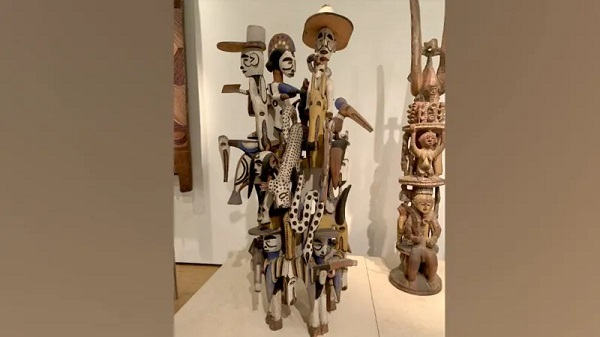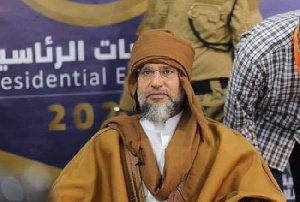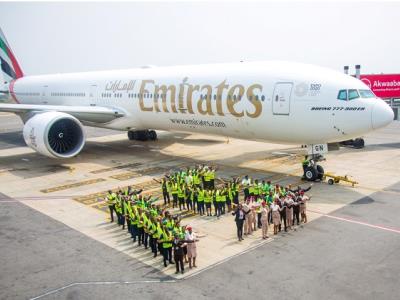The journey that helped save Nigeria’s art for the nation

The Nigerian National Museum in Lagos sits in the city like a respected but unloved relative – it somehow exudes importance but remains largely unvisited.
This is perhaps because the concept of a museum is based on a colonial idea – stuffing cabinets full of exoticised objects removed from the context that gave them any meaning.
Olugbile Holloway, who was appointed earlier this year to head the commission that runs the National Museum, is keen to change this – he wants to take the artefacts on the road and get them seen back where they once belonged.
“How organically African [is this concept of a museum] or has this ideology kind of been superimposed on us?” he asked me.
“Maybe the conventional model of a nice building with artefacts and lights and write-ups, maybe that isn’t what’s going to work in this part of the world?”
Established in 1957 – three years before independence – the museum houses objects from across the country, including Ife bronze and terracotta heads, Benin brass plaques and ivories, and Ibibio masks and costumes.
But there is also an irony – Mr. Holloway’s job would not exist if the antiquities department, set up by the colonial government, had not got people to go around the country to collect the pieces that ended up in the museum.
Some may have otherwise been stolen by Western visitors with fewer scruples to be sold on the lucrative European and American artefacts market. While others could have been destroyed by zealous Nigerian Christians convinced that they were the devil’s work.
In 1967, an unlikely American duo of Charlie Cushman, a hitchhiker, and Herbert “Skip” Cole, a postgraduate student, were sent around the country by the antiquities department, to gather up some of the heritage.
“It was an incredible opportunity to spend – what was it, two weeks? – to venture into small enclaves and villages in south-eastern Nigeria,” Mr Cushman, now 90, told me.
At that time, significant cultural artefacts were kept in traditional shrines, palaces, and sometimes caves. They were often central to the area’s traditional religions.
Household heads and shrine priests were responsible for maintaining and protecting these items.
“What I found particularly interesting is that many people in the villages seemed very willing to part with masks and objects that had been in their families for a long time,” 89-year-old Mr Cole told me.
“I was able to buy masks for two or three dollars. They would be worth hundreds in Europe at the time.
“Its monetary value wasn’t important in Igbo villages. They used the objects for ceremonies, for entertainment, for commemorating ancestors and nature spirits… which is probably why they were able to sell things inexpensively when they decided that they were no longer useful to them.”
Mr. Cushman kept detailed journals of his experiences as they travelled together in a VW minibus and on foot to retrieve these artworks, including ceremonies they observed and people they met – and those handwritten notebooks have survived more than 50 years.
I was especially fascinated by their efforts to persuade Christian converts not to destroy artefacts, which they considered pagan and evil.
The diaries describe meeting a Mr Akazi, a school headmaster and “self-appointed crusader of God” who had burnt some ancestral figures.
“They are evil and remain as crutches to the people. Only with their destruction can we rid the people of these monstrous influences,” Mr Akazi is quoted as saying.
Mr. Cole tried his best to explain.
“We are here to try and preserve these art objects for future generations. Rather than destroy them, could we not have them sent to the Lagos Museum where they will accomplish both of our purposes? For you, they will no longer be here to serve as obstructions to Christianity, and for us, they will be preserved.”
It seems that the headmaster was persuaded to hand them over, but did not see their cultural value.
“You see for me there are too many emotional ties connected with these hideous manifestations of Satan. Perhaps for you, these things are art, but they can never be so for me,” Mr Akazi said.
Reading those excerpts reminded me of the times I accompanied compatriots, who were visiting me in London, to the British Museum to see some of the Nigerian artwork on display, mostly looted from our country.
Some of my guests, who were committed Christians, refused to take photographs of themselves standing with any of the objects, concerned that they might be fraternising with demonic items. We laughed about it, but they were serious.
Mr Cushman studied at Yale and Stanford Universities. He turned down the opportunity to work with investment company Merrill Lynch in New York, eventually deciding to travel the world. He ended up in Nigeria where he met Mr Cole, an old school friend, and was persuaded to join him on his mission.
The journals that Mr. Cushman kept are all that survive the trip.
Unfortunately, “Skip” lost all his own records when he was forced to flee south-east Nigeria during the civil war, which started in July 1967 when the region’s leaders seceded from Nigeria and formed the nation of Biafra.
He was sad to learn later that some of the artwork he had collected for the museum in the southern town of Oron had been destroyed.
“The Nigerian army took over the museum because it was the only building around with air-conditioning so they would use artefacts as firewood to cook their food,” he said.
But much of what the two men, and others, collected survived and is now the responsibility of Mr Holloway as the head of the Nigerian Commission for Museums and Monuments.
He hopes to develop a new concept of a museum that is more appealing to, and representative of, Nigerians and Africans.
“We have about 50-something museums across the country and the vast majority are not viable, because people are not interested in going into a building that has no life.
“To the white man or to the West, what they would call an artefact to us is a sacred object… I feel that the richness in those objects would be to display them as they would originally have been used.”
Source: bbc.com




